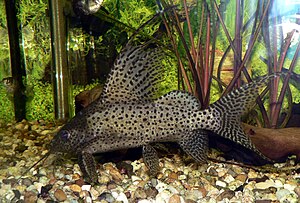Feathered whiskered catfish
| Feathered whiskered catfish | ||||||||||||
|---|---|---|---|---|---|---|---|---|---|---|---|---|

Whiskered catfish ( Synodontis eupterus ) |
||||||||||||
| Systematics | ||||||||||||
|
||||||||||||
| Scientific name | ||||||||||||
| Synodontis eupterus | ||||||||||||
| Boulenger , 1901 |
The Schmuckflossen- , Hochflossen- or spring fin Fiederbartwels ( Synodontis eupterus ) is a member of the type comprising over 130 species Synodontis that to the subfamily of Catfishes ( Mochokinae ) family Mochokidae belongs. The species was scientifically described as Synodontis eupterus as early as 1901 . The species name is from the Greek and is derived from eu , for 'beautiful' and pteron for 'fin'. It is true that the first importation of these catfish for aquarium purposes can no longer be precisely determined, but around 1990 it appears in the hobby literature.
features
The distinguishing feature of this catfish is, as the names suggest, the dorsal fin , the front rays of which are greatly elongated in adults. Young animals, on the other hand, have a narrow, slightly wavy, almost white vertical line on the tail stalk , before and after the adipose fin , which is surrounded on both sides by a dark edge. At this age, the fins are also more or less banded. With increasing age, the white line disappears and the edge and the bands visibly dissolve into individual points. After all, the whole body is covered with small, blackish dots, not too closely spaced. The basic color is brownish olive.
Occurrence
The distribution area extends from the middle Nile ( Lake No is the type locality ) over the Chad Basin to the Niger and Volta systems .
size
Depending on the source, there is talk of a total length of 15 to 23 centimeters.
Behavior and Reproductive Biology
A special feature of these catfish is that they sometimes swim on their backs. This may be because they like to stand under roots, belly up. If they then scurry from one root to the other, well covered, it may not be worth turning around to cover the small distances. The back swimming Congo cat uses this special swimming position even in "continuous operation". Since individual other Synodontis species are also noticeable in this way, the whole family is also called "Upside-Down Catfishes" in English. S. eupterus is considered a peaceful keeper in the aquarium. However, this catfish should not be kept with fish that pluck fins, as the elongated fin rays of the dorsal fin particularly animate such species.
The reproduction of the whiskered catfish is not exactly known, but it is assumed that they are free-spawners . Although S. eupterus could not be bred purely in captivity, hybrids of this species are offered in the ornamental fish trade. These are mainly achieved in Eastern Europe through hormone injections ( pituitary extracts ).
Synonyms
- Synodontis galinae Kochetov, 1998
- Synodontis macrepipterus Pellegrin, 1922.
swell
- Poll, M. (1971): Révision des Synodontis Africains (Famille Mochocidae) . Annales du Musee Royal de l'Afrique Centrale, Ser. 8, Zool. 191: 1-497.
Individual evidence
- ^ Boulenger, GA (1901): Descriptions of three new siluroid fishes of the genus Synodontis discovered by Mr. WLS Loat in the White Nile . On. Mag. Nat. Hist., (7) 8 (43): 10-12.
- ↑ Seidel, I. (2008): Caution, hybrids! . D. Aqu. u. Terr. Z. (DATZ), 61 (12): 20-23.
- ↑ Kochetov, A. (1998): A new Synodontis species . The Aquarium, 2: 44-45. (in Russian)
- ^ Pellegrin, J. (1922): Poissons du Gribingui recueillis par M. Baudon. Description d'un Mormyridé et d'un Characinidé nouveaux . Bull. Soc. Zool. France, 47: 220-223.
Web links
- Feathered whiskers on Fishbase.org (English)
- Synodontis eupterus in the Red List of Threatened Species of the IUCN 2013.2. Posted by: Awaïss, A., Getahun, A. & Lalèyè, P, 2009. Retrieved January 10, 2014.
